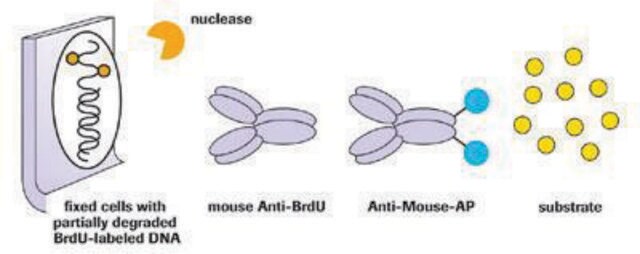QIA58
BrdU Cell Proliferation Assay
This proliferation assay is a non-isotopic immunoassay for quantification of BrdU incorporation into newly synthesized DNA of actively proliferating cells.
Synonyme(s) :
Bromodeoxyuridine Assay
About This Item
Produits recommandés
Niveau de qualité
Utilisation
sufficient for 1000 tests
sufficient for 200 tests
Conditionnement
pkg of 1 96-well plate(s)
Fabricant/nom de marque
Calbiochem®
Conditions de stockage
OK to freeze
avoid repeated freeze/thaw cycles
Entrée
sample type intact cells
sample type intact cells
Méthode de détection
colorimetric
Conditions d'expédition
wet ice
Température de stockage
−20°C
Description générale
Composants
Avertissement
Caractéristiques
Principe
Stockage et stabilité
Prior to use:
1. Remove the Fixative/Denaturing Solution and place at room temperature for at least 4 h prior to use. Precipitates that may occur while cold should go back into solution.
2. Reconstitute the Peroxidase Goat Anti-Mouse IgG with the appropriate volume of 1X PBS.
• For the 200 test kit, reconstitute Peroxidase Goat Anti-Mouse IgG in 125 µl of 1X PBS. Use Conjugate Diluent for any further lot-specific dilution.
• For the 1000 test kit, reconstitute Peroxidase Goat Anti-Mouse IgG in 250 µl of 1X PBS. Use Conjugate Diluent for any further lot-specific dilution.
Allow solution to stand at room temperature for 10 min. (or until solution is clear). Divide into small aliquots; aliquots not to be used that same day should be stored at -20°C in a non-frostfree freezer.
Once the kit components have been thawed for use:
• The BrdU label and 100X Anti-BrdU Antibody should be divided into small aliquots and stored at -20°C in a non-frostfree freezer with the Peroxidase Goat Anti-Mouse IgG; avoid multiple freeze/thaw cycles.
• All the other kit components (Substrate, Antibody Diluent, Conjugate Diluent, 20X Plate Wash Concentrate, Fixative/Denaturing Solution, Stop Solution) should be stored at 4°C.
Autres remarques
Muir, D., et al. 1990. Analytical Biochemistry185, 377.
Lanier, T. L., et al. 1989. Carcinogenesis10, 1341.
Magaud, J.-P., et al. 1988. J. Immunol. Methods106, 95.
Collins, S.J. 1987. Blood70, 1233.
Porstmann, T., et al. 1985. J. Immunol. Methods82, 169.
Raza, A., et al. 1985. Cytometry6, 633.
Morstyn, G., et al. 1983. J. Clin. Invest.72, 1844.
Gratzner, H.G. 1982. Science218, 474.
Informations légales
Mention d'avertissement
Danger
Mentions de danger
Conseils de prudence
Classification des risques
Carc. 2 - Eye Irrit. 2 - Flam. Liq. 2 - Met. Corr. 1 - Muta. 1B - Repr. 2 - Skin Irrit. 2 - Skin Sens. 1
Code de la classe de stockage
3 - Flammable liquids
Point d'éclair (°F)
69.8 °F
Point d'éclair (°C)
21 °C
Certificats d'analyse (COA)
Recherchez un Certificats d'analyse (COA) en saisissant le numéro de lot du produit. Les numéros de lot figurent sur l'étiquette du produit après les mots "Lot" ou "Batch".
Déjà en possession de ce produit ?
Retrouvez la documentation relative aux produits que vous avez récemment achetés dans la Bibliothèque de documents.
Les clients ont également consulté
Articles
Quality control guidelines to maintain high quality authenticated and contamination-free cell cultures. Free ECACC handbook download.
Quality control guidelines to maintain high quality authenticated and contamination-free cell cultures. Free ECACC handbook download.
Quality control guidelines to maintain high quality authenticated and contamination-free cell cultures. Free ECACC handbook download.
Quality control guidelines to maintain high quality authenticated and contamination-free cell cultures. Free ECACC handbook download.
Notre équipe de scientifiques dispose d'une expérience dans tous les secteurs de la recherche, notamment en sciences de la vie, science des matériaux, synthèse chimique, chromatographie, analyse et dans de nombreux autres domaines..
Contacter notre Service technique













